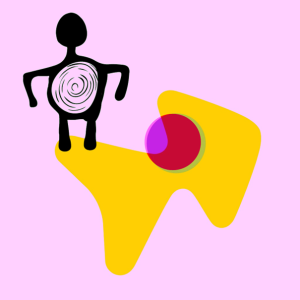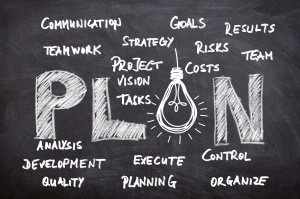'leadership'
Insights from the leadership planet by Eve and Eli
2024 is soon coming to an end. Often a lot of things need to be finalized before Christmas (work wise as well as in our private lives). Everything needs to be done near to perfect, and the clock is ticking. It can become a very stressful period.
When we get stressed, it impacts the part of our brain called the Amygdala – one of the oldest parts of the brain which plays a big role in processing emotions, especially fear, threats and stress. Acute stress triggers and increases Amygdala activity. This enhances the brain’s ability to detect potential dangers and initiate a fight-or-flight response. This is of course very helpful in immediate survival situations, but not necessarily in our day-to-day life. Chronic stress can lead to an overactive Amygdala, making you more sensitive to perceived threats and prone to anxiety, can lead to difficulties to focus and sleep.
So how can we help to calm down the activity level in our Amygdala?
An interesting experience is taking place in a laboratory at the Max Planck Institute in Berlin, where the brain researcher Sonja Sudimac is scanning the brains of a group of 63 individuals to investigate what happens in their amygdala, the part of the brain that is supposed to warn us of dangers, when they are in different environments. One thing that is researched is what happens in our brain if we take a walk. Taking a walk is of course good - we get out and we get some exercise. But taking an hour's walk in an urban environment led to continued high activity in an already stressed amygdala. After an hour's walk in the forest, the activity in the amygdala had decreased significantly.
So, when you are stressed try to fit in a walk but make sure to use the power of the green areas. You are not always close to a forest but perhaps you have a green park nearby where you can give your brain a chance to calm down and re-charge.
Make sure to take care of yourself and your brain so that you can fully enjoy the coming Christmas break.
More to come from Insights from the Leadership Planet by Eve and Eli
Insights from the leadership planet by Eve and Eli
Hybrid teams are here to stay. After the pandemic this is the new normal – mixed teams with team members working on site, hybrid or even remote. More and more companies are though deciding that they want their employees to be more in the office, well at least three days a week. So, hybrid will be the new normal and in this new environment good leaders are critical.
Leaders need to manage hybrid teams, allowing their employees to work both remotely and in the office. They need to execute some leadership traits probably both better as well as clearer.
Therefore, what do you need to think about a bit extra as a leader:
- make sure you establish clear rules of engagement and developing daily rituals so that everyone knows what is expected. Is this new – no – but it become even more important when you do not have the time to see your employees daily.
- avoid virtual micromanagement and trust that employees will get the job done.
- equip you employees with the skills they need to succeed now as well as in the future by providing appropriate development.
- encourage your employees to contribute to the team spirit by connecting with colleagues in the office and with remote colleagues. Leaders cannot be the only glue to create connection and belonging.
- to ensure that employees working remotely have the right tools to be able to do the work in an effective way.
- make sure to handle meeting facilitation effectively by for instance clear agenda, restating, and summarizing office conversations to clarify for those on the phone or video chat.
Finally, leaders need to continue to develop themselves in order to improve retention, engagement and performance behaviors. It will be key to manage the hybrid workplace and hybrid teams in an effective manner.
What do you need to develop to be an effective hybrid leader?
More to come from Insights from the leadership planet by Eve and Eli
Insights from the leadership planet by Eve and Eli
In the fast-paced world of leadership, where data-driven decisions and logic often reign supreme, there’s an often-overlooked superpower: intuition. In fact, intuition is much more present in our life than what we think or are aware of. It is a knowledge that comes from old ages, when we were living in caves having to deal with animals around and huge uncertainty.
Intuition is the silent whisper that nudges us toward certain choices. It’s not a mystical force but rather an innate ability we all possess. Imagine it as your internal compass, guiding you through the fog of uncertainty. Let’s explore what intuition truly is:
- The Subtle Signal: Intuition doesn’t shout; it whispers but so deeply that you know you’re right! It’s that inexplicable feeling when for example you meet someone and sense their authenticity or discomfort. It’s the hunch that nudges you toward a decision, even when data points elsewhere.
- Beyond Rationality: Intuition transcends logic. While analysis and facts have their place, intuition taps into deeper wisdom. It’s the bridge between conscious thought and subconscious insight.
- Body and Mind: Intuition isn’t just in your head; it resonates throughout your body. Pay attention to physical sensations—an uneasy stomach, a racing heart—when making choices. Research as demonstrated that your body often knows before your mind catches up.
- Practice and Trust: Cultivating intuition takes practice, like a muscle. Quiet moments, meditation, and self-reflection help. Trust it—especially when it defies conventional wisdom. Intuition thrives when you listen without judgment.
Connecting to your inner compass could completely transform your leadership journey, it brings so many opportunities for development:
- Empathy and Connection: Intuition enhances your ability to empathize and connect with others. By tuning into your instincts, you better pay attention to others, ask more questions and understand better team members’ feelings, needs, and motivations.
- Creativity and Innovation: Intuitive leaders think beyond the obvious. They’re not bound by rigid frameworks.
- Big-Picture Focus: Intuition helps you keep your eyes on the horizon. While details matter, intuitive leaders maintain perspective and keep an eye on their environment.
- Authentic Decision-Making: Trusting your intuition means aligning with your core values, connecting to your inner self. When ego steps aside, conscious choices emerge.
- Navigating Complexity: In our century of complexity and overload of information, intuition acts as a compass. It guides you through uncertainty, helping you respond to challenges with clarity and grace.
So, embrace and train this quiet force. It’s your compass, pointing toward purpose and authenticity.
More to come from Insights from the leadership planet by Eve and Eli
INSIGHTS FROM THE LEADERSHIP PLANET
by Eve and Eli
We have been asked to many times “do you think I should take a coach”… any time someone asks this question, without needing further explanation, the answer is YES, not because we will do more business it is just because if you’re asking the question, you are deeply and sometimes not consciously needing help.
We’ve decided to list all the powerful reasons why you should take a coach… Maybe you find one (or more!) which sounds a (big) bell:
- Combat Executive Isolation: As you climb the corporate ladder, feelings of isolation and loneliness can increase due to the unique stress and responsibility. An executive coach not only addresses specific issues but also helps mitigate these feelings by connecting you with others who share similar experiences.
- Build Thought Leadership: An executive coach can guide you in shaping your personal brand. They help you decide how to present yourself on platforms like LinkedIn, identify conferences to speak at and develop strategies to enhance your online presence.
- Refine Executive Presence: Improve your communication skills and influencing abilities. Coaches assist with presentations, one-on-one meetings, and team interactions, allowing you to elevate your executive presence1.
- Operate in Your Zone of Genius: Contrary to the misconception that coaches only focus on weaknesses, they also help you identify and leverage your strengths. By emphasizing your fabulousness, you can excel in your leadership role.
- Holistic Development: An executive coach takes a comprehensive approach to your growth. They focus not only on professional skills but also on personal development. By addressing both, you become a more well-rounded leader.
- Strategic Thinking: Coaches encourage strategic thinking. They help you step back, analyze situations, and make informed decisions. This skill is crucial for navigating complex business landscapes.
- Emotional Intelligence: Effective leadership requires emotional intelligence. Coaches guide you in understanding your emotions, managing stress, and building strong relationships with your team.
- Accountability and Goal Setting: Coaches hold you accountable for your goals. They help you set clear objectives, track progress, and adjust strategies as needed.
- Conflict Resolution: Leaders often face conflicts. Coaches equip you with conflict resolution techniques, ensuring a harmonious work environment.
- Adaptability: In today’s dynamic world, adaptability is key. Coaches help you embrace change, learn from failures, and stay agile.
Remember, investing in an executive coach isn’t a sign of weakness—it’s a commitment to continuous improvement and exceptional leadership!
Here a question to you - When do you start???
More to come from INSIGHTS FROM THE LEADERSHIP PLANET by Eve and Eli
Insights from the leadership planet by Eve and Eli
We can use a lot of metaphors to reflect on ourselves. They are nice shortcuts to understand feelings that move us towards action. We have gathered the most important ways of representation for trust.
Which kind of image would you chose to represent the type of Trust you would like to inspire in others?
- "A Lion”: strength and tenacity, like a lion in its environment, asserting ideas, defending objectives and leading the discussion.
- "A Rock": stability and solidity, like an unshakeable rock, reassuring anchor for those around.
- "A Ship Sailing Serenely in Turbulent Waters": remaining calm and in control, even in difficult or uncertain situations.
- "A Tree with Deep Roots": experimented and resilient, well-anchored and able to withstand challenges.
- "A Shining Star: standing out in a crowd, captivating the audience and leaving a lasting impression.
- "A Blazing Torch": source of light and guidance for self and others.
- "A Diamond in the Rough": with modest appearance but with something precious and special that may not be immediately visible to others.
- "A mountain peak": reaching a top goal thanks to tenacity and effort.
- "A soaring Eagle": overcoming challenges and soaring to new heights, pursuing dreams.
- "A Flower Blossoming in the Sun": empowerment and growth
Once you have your image, keep it in mind and do your best to align your vocabulary, actions and behaviors with it. Are you able to find out your team members’ metaphor?
Next time read our piece on Giving your brain vacation from Insights from the leadership planet by Eve and Eli
Insights from the leadership planet by Eve and Eli
Change is a part of our working life. It might be small changes involving only a few or larger changes affecting many parts of the organization in order to adapt to changed market conditions, to gain access to a market or a market segment, make delivery, production, ways of working more efficient. When doing changes, we are convinced that the investment made will lead to synergistic effects - i.e. one will earn back one's investment. If you have done your homework correctly (i.e. not been too optimistic or skipped your due diligence), the synergies are also usually realistic - at least on paper.
In the event of a change, in general we talk about three different aspects you need to take into consideration – the strategic, structural and cultural aspects of change
Strategic changes/decisions i.e. when we define the objectives, expected results and the reasons that drive the changes. It will answer the questions
- WHY are we doing it/what are the reasons for it?
- WHY are we doing it now?
- WHAT should it lead to/what should we achieve?
In changes this aspect is nearly always completed and people involved can agree upon or at least accept the reasons and benefits. You understand why it is good and why you should do it and why you should do it now, etc.
Structural changes/decisions are more about WHAT needs to be done to support the strategies, i.e. the structural changes that must be made in the organization, support systems, budget, processes and skills needed etc. This is also usually included in the plan - sometimes you may not realize everything that will be affected, but in general it is part of the plan.
Finally, there is a cultural change/decision aspect to change, i.e. to make sure that this change will pay off, you need to know HOW things potentially need to be done differently and what behaviors are necessary to adapt. It applies to various aspects of behavior. There might be need for differences in how you set goals and follow up, how you set up incentive programs, how you work with meeting structure, working methods and cooperation between teams and individuals. It will affect leadership as well as sometimes the norms and values.
This last piece of the puzzle many find more difficult to work with - either you underestimate this part, you are unaware of these aspects, or it is simply difficult to work with these "softer parts of change" so you just hope for the best. In order to get the full effect of a change, you need to understand you current ways of working and behavior and how things will have to change or adapt.
Change often means doing something differently - doing more or less of something, stop or start doing something. People don't do things based on intention; they do things based on consequences – to understand what will be gained by the change or the pain of not doing it. A changed behavior is about understanding, learning and proper training as well as those affected feeling involved and part of the dialogue. Leadership is really important in all type of changes – leaders need to understand all aspects of change, to drive the change as well as coach and support the people affected by the change.
Change is a given in today’s world of works. Plans for change are great but it is still people who make these changes happen. To be successful in change you need to have focus on all three aspects – strategic, structural and cultural. So, what do you need to prepare to make sure you make you change will be successful?
Read about TRUST, next from Insights from the leadership planet by Eve and Eli
Senaste inläggen
Senaste kommentarer
Arkiv
Länkar
Etiketter
feedback trust arbetstagare search change tid arbeta under press brain research risk och kontroll introvert målstyrning resiliens värdegrund brain vacation johari fönster onboarding arbetsliv headhunting millenials fantastiska ledaare platta organisationer holakrati remote management beteendestilar utveckla medarbetare nätverk openness förändringsledning självdisciplin pandemi skjuta upp incitament arbetsgivare nyckelkompetenser trygghet sätta mål reflektera vägval remot management go with the flow tvivel hybrid teams extrovert delegera semester framgång värdeord middle management re-charging inspiration emotionalintelligence arbetssätt employer branding busyholic modiga ledare seminarier framtid rädsla karriärhinder lärande livsintentioner balans beslutsfällor change management det goda ledarskapet goda samtal söka jobb karriärcoaching självledarskap karriär engagemang karriärplanering leadership styrkor mål förändring personlig utveckling personligt ledarskap coaching ledarskap rekrytering karriärutveckling ledarutveckling grupputveckling outplacement motivation assessment effektiva möten strengthsfinder osäkerhet team kravprofil karriärmål personliga egenskaper fatta beslut talanger samtal nätverka tystnad att leda andra mentoring mod referenser talent management stress kompetensutveckling learning leda på distans ledaregenskaper megatrender motivationsfaktorer energi ledare executive coaching kundfokus emotional intelligence ledningsgrupp nystart fira segrar platsannonser self-management misslyckande kreativa möten eq strategisk kompetensutveckling åldersdiskriminering linkedin 50+ self regard vacation växande unbossing lyssnande lycka intuition konflikt hantera hinder vara nöjd distansledarskap kunskapsöverföring kompassriktning arbete aspects of change svagheter autentiskt ledarskap prokrastinera distansarbete litteratur leadership development medarbetare hybrid workplace självförtroende rättvisa mötesstruktur lyckoindex ledarskapet people management drömjobb chef
 0 kommentarer
0 kommentarer 










Helge Nilsson » 10 saker effektiva team fokuserar på: ”Vad effektiva team fokuserar pa är ett ämne man kan skriva mycket om. Hade gärna..”
Helge Nilsson » Who would you like to be?: ”Really good visual symbols! I could definitely work with these. One of my coache..”
Mais Hasan » Självdisciplin – låter tråkigt men viktigt för framgång: ”Hej, Vem skrev den artikeln? Tack på förhand Mvh Mais”
Lars Ander » Sex megatrender som påverkar arbetslivet, karriären och ledarskapet de kommande 10-15 åren: ”Optimalt träff för det nya ledarskapets prognos. Delat detta och fått många posi..”
Åsa Bergman Målbäck » Söka jobb på 40-talet: ”Det är en gruvlig tur att vi har slutat kontrollera tungbett :-).”